Ever since I stepped into the B2B SaaS world back in 2021, I’ve wondered why some companies with great products crash and burn while others thrive. I kept hearing the term “sales pipeline” thrown around, but I didn’t really understand just how important it was until I started seeing patterns.
I’ve seen companies with incredible tech and millions in funding shut down within a year. Not because the product sucked. Not because the market wasn’t there. But because they had no clue how to track their sales process.
In this guide, I’ll break down everything you need to know about sales pipelines — what they are, why they matter, and a step-by-step process to build and manage one that actually drives results.
Let’s dive in.
Download the Sales Metrics & KPI Calculator
Table of Contents
- What is a sales pipeline?
- How to Build a Sales Pipeline
- How to Run a Sales Pipeline Review
- How to Clean Up Your Sales Pipeline
- Sales Pipeline Analysis: Key Sales Pipeline Metrics to Track
- An Easy Sales Pipeline Template
- Ready for Sales Pipeline Management?
What is a sales pipeline?
A sales pipeline is a visual snapshot of where your deals are in the sales process. It shows the key stages a potential customer moves through — from the first “Hey, I’m interested” to the final “Let’s do this” handshake. Think of it as a map that helps you (and your team) track, organize, and move deals forward with purpose.
Every company has its own flavor of a sales process. Even within the same company, pipelines can look different depending on the product or service you're selling. That’s why there’s no one-size-fits-all setup.
Your sales pipeline should reflect the buyer’s journey in your specific business context. Otherwise, you're just plugging leads into a system that doesn’t match how they actually buy.
I remember one time a rep on a sales team I worked with got an inbound message from someone who had already talked to three of our customers, secured budget approval, and wanted a demo that week. Instead of walking through the usual qualification steps, we jumped straight to decision-making and pricing.
Some prospects move fast — others stall. Some show up ready to buy, already sold on your product after doing their homework. Others need more nurturing. And that’s the beauty of a sales pipeline: it allows you to adjust your sales approach based on where someone is and how fast they’re moving.
A well-built sales pipeline also gives you visibility into your revenue. Sales managers can forecast more accurately by looking at where each deal sits in the pipeline, how long it’s been there, and how likely it is to close. It’s a simple tool, but when used right, it becomes a powerful engine for growth.
Typical Sales Pipeline Stages
While the specific stages can vary depending on your industry and sales process, a typical sales pipeline includes the following stages:
Prospecting
This is the first step, where you actively search for potential customers who might benefit from your product or service. If you’re selling software, that might mean identifying companies in a certain industry or size range that struggle with the problem your solution solves.
Lead Qualification
Once you’ve identified some leads, the next step is figuring out if they’re a good fit. You assess things like their needs, budget, buying timeline, and whether you’re speaking to someone with decision-making power.
Pro tip: I like to use a “reverse qualification” approach, where you actively look for reasons to disqualify leads. This saves time and helps your team focus on prospects who are actually worth pursuing.
Initial Contact
Here, you reach out to qualified leads via email, phone, or social channels. The goal is to start a conversation, learn more about their pain points, and provide enough value upfront to keep the door open for deeper engagement. This stage is about listening, not pitching.
Proposal
If the lead is engaged and there’s clear interest, you move to presenting a formal proposal. This should be tailored to their specific needs and include pricing, features, and key benefits. The proposal isn’t just a document — it’s your chance to make a strong case for why your solution is the right one.
Negotiation/Commitment
At this stage, both sides work through the final terms, such as pricing, contract details, implementation timelines, and any lingering concerns. Strong negotiation skills help remove roadblocks and move the deal toward a close without stalling momentum.
Closing (or Lost)
This is where the deal is either won or lost. If you close successfully, you move forward with onboarding or implementation. If not, you need to log why the deal didn’t go through. Those insights can help refine your messaging, improve your sales process, and increase your win rate over time.
Pro tip: I like to use this sales conversion and close rate calculator!
.png)
Free Sales Metrics Calculator
A free, interactive template to calculate your sales KPIs.
- Average Deal Size
- Customer Acquisition Cost (CAC)
- Customer Lifetime Value (CLV)
- And more!
Download Free
All fields are required.
.png)
Sales Pipeline vs. Sales Forecast vs. Sales Funnel
Sales Pipeline vs. Sales Forecast
People often confuse “sales pipelines” with “sales forecasts,” but they are completely different.
A sales pipeline is a visual representation of where prospects are in the sales process. It tracks potential customers from initial contact through various stages until the deal is closed or lost.
On the other hand, a sales forecast estimates the future sales revenue for a specific time period, usually based on historical data, market trends, and current pipeline information.
For example, if a sales forecast anticipates missing your quota, you should double down on selling activities. But if it estimates a 150% growth compared to the last month, you'd want to scale back your efforts and start laying the groundwork for an equally successful next month.
While sales pipelines and forecasts are distinct, they are closely related. An accurate and well-managed pipeline is crucial for creating reliable sales forecasts. Once you've started tracking your sales pipeline, that data can allow you to create a forecast using sales forecasting software like Sales Hub.
Sales Pipeline vs. Sales Funnel
People also often use “sales pipeline” and “sales funnel” interchangeably.
However, a sales funnel suggests that the number of prospects you're working with will drop consistently as the sales process continues.
This leads to a false belief that you need three times as many prospects at the top of your funnel as at the bottom. For instance, a sales manager following this philosophy would ask his rep to connect with 300 buyers to close 100 deals.
Sales educator and expert Jeff Hoffman clears this misconception by calling a sales pipeline a wide-mouthed cocktail glass instead of an evenly shaped funnel.
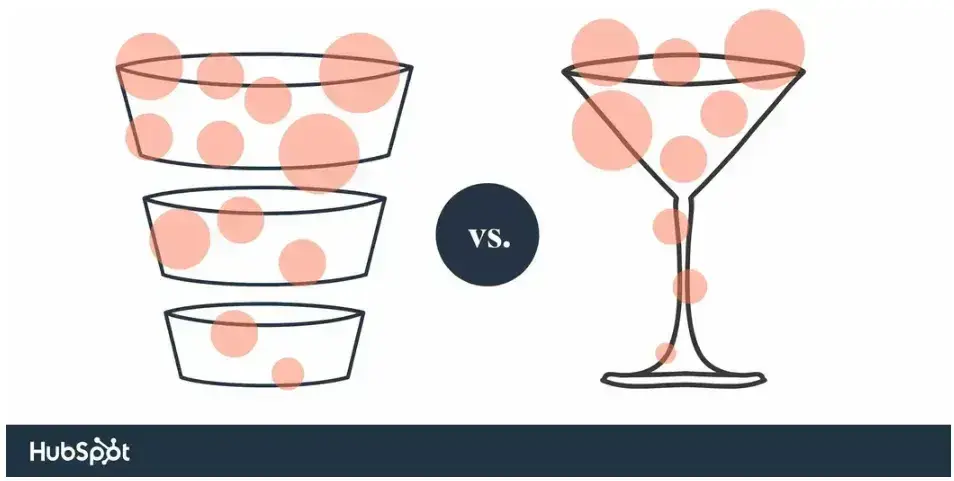
You may have a ton of prospects entering your pipeline, but the vast majority drop off after the qualification stage. After prospects have passed the critical point, most should become customers.
How to Build a Sales Pipeline
Building a sales pipeline is one of the smartest moves you can make if you want to grow your business. I’ve seen companies take different approaches to it, but the payoff is always worth it.
How long will it take to build your own sales pipeline? That depends on your product, audience, and team.
However, here are the key steps to get you started.
1. Define the stages of your sales pipeline.
While copying a template might be the quickest way to define your sales pipeline stages, taking the time to develop your own will pay off in the long run. Your pipeline should reflect your buyer’s journey, helping you track progress and accurately forecast revenue.
While every customer’s path is unique, they generally follow a similar process:
- Awareness. The buyer realizes they have a problem or opportunity and begins looking for a solution.
- Consideration. The buyer further defines the issue, establishes criteria for evaluation, and starts researching potential solutions.
- Decision. The buyer has narrowed down their options and compares vendors or solutions before making a final choice.
To illustrate, check out this hypothetical buyer's journey:
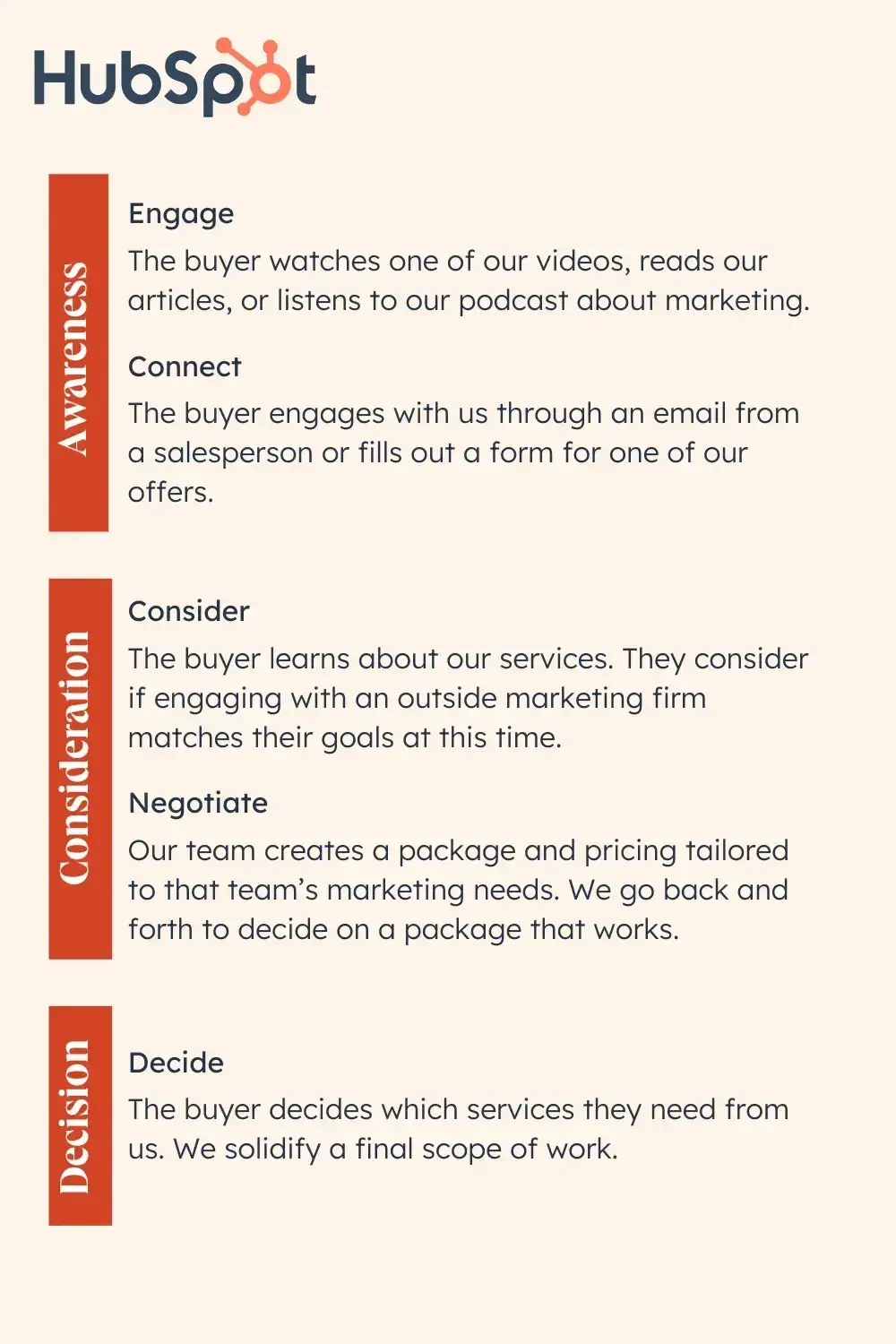
Translating that journey into your sales pipeline stages might look like this:
- Connect. This is when a lead first interacts with your brand. It could be through an email from a salesperson, a webinar, or content they've engaged with on your site. The goal here is to make the initial touchpoint meaningful and relevant.
- Appointment Set. Once the lead shows interest, you schedule a meeting to dive deeper into their needs and how you can provide a solution.
- Appointment Completed. After the meeting, you have a clearer picture of their needs, and they’ve heard your pitch. This stage is about confirming the next steps and keeping the momentum going.
- Solution Proposed. At this point, the buyer is interested in using your product to address their pain point or capitalize on an opportunity. You propose how your solution fits into their strategy, highlighting key benefits and value.
- Proposal Sent. This is the stage where the buyer reviews your proposal or contract. They’re now evaluating the specifics of your offering, like pricing, terms, and implementation.
Note: These stages can vary based on your product complexity. A simple product might have fewer sales pipeline stages, whereas a more complex one will require more detailed touchpoints and longer sales cycles. As your product becomes more sophisticated, your pipeline stages should evolve to meet the needs of your buyers.
.png)
Free Sales Metrics Calculator
A free, interactive template to calculate your sales KPIs.
- Average Deal Size
- Customer Acquisition Cost (CAC)
- Customer Lifetime Value (CLV)
- And more!
Download Free
All fields are required.
.png)
2. Identify how many opportunities continue through each stage.
You should know how long prospects spend in each stage, both across the board and for closed/won deals. For example, the average prospect may spend two weeks in the demo stage, while those who eventually buy spend three weeks.
You should also know the percentage of opportunities that advance to the next stage.
And it's critical to establish yield probability (or conversion rate) per stage. Perhaps prospects are 75% likely to buy in the demo stage and 90% likely to buy in the negotiation stage. Once you've assigned these percentages to each stage, you can develop monthly or quarterly revenue estimates.
Knowing these benchmarks will help your reps and sales managers predict which opportunities will likely close.
3. Calculate the opportunities you need to hit your goals.
Now you can work backward to determine how many opportunities you need in each pipeline stage. Start with your target monthly or quarterly revenue divided by your average deal size, so you know how many deals you need to win.
Next, divide your target deal number by your yield probability per stage. If you need to win 135 deals, and your reps typically close 90% of deals in the negotiation stage, 150 opportunities must reach that stage in a month.
Repeat this process for every stage. Once you have total milestones, you can divide these goals by salesperson.
Here's an example from Bob Marsh, CEO of LevelEleven. Assume you need 2,000 deals per year to hit your target bookings.
- 2,000 deals/year = 167 deals per month
- 8,000 proposals/year = 667 proposals per month
- 32,000 meetings/year = 640 meetings per week
- 64,000 calls/year = 256 calls per day
If you have a 100-person team, that translates to:
- 167 deals per month/100 reps = 2 deals per month
- 667 proposals per month/100 reps = 7 proposals per month
- 640 meetings per week/100 reps = 7 meetings per week
- 256 conversations per day/100 reps = 3 calls per day
Salespeople can use these benchmarks to measure their progress against the targets.
Keep in mind that every rep‘s conversion rates will vary by stage. For example, if one of your salespeople struggles to prospect but has an excellent demo-to-close rate, they’ll need fewer initial meetings than their peers to meet the quota.
4. Understand the commonalities between opportunities that convert.
Next, pinpoint the common characteristics of opportunities that convert for every stage. This means looking for patterns in both the actions of your sales reps and the responses of your prospects.
For example, you may notice that leads who respond positively to follow-up emails within 48 hours are more likely to move forward. Or maybe prospects who ask detailed questions during your demo tend to close at a higher rate. These patterns give you valuable insight into which actions and interactions drive conversions.
You might also discover trends in the types of prospects who convert. Perhaps companies in a specific industry are more responsive, or leads from certain marketing channels (e.g., referral-based or inbound leads from high-value content) have a higher chance of success.
Recognizing these trends helps you not only refine your targeting and lead generation efforts but also streamline the sales process itself.
5. Create or adapt your sales process around this data.
Once you’ve identified the key actions and behaviors that drive successful conversions, shape your sales process around these insights. If you don’t have a defined sales process yet, this is the perfect opportunity to create one; if you do, it's time to update it based on what the data is telling you.
For example, if you’ve found that follow-up emails within 48 hours increase conversion, build that timing into your process. Or if you know that leads who engage with specific content are more likely to convert, create actions in your process that prompt reps to share this content at key stages.
By adapting your sales process around these insights, you set your team up for more success and ensure that prospects move smoothly toward a close.
6. Continuously add leads to your pipeline.
Establishing a sales process isn’t enough, though. As many reps aren‘t too big on prospecting, it’s easy to end up with a dry sales pipeline once you build one.
Since many sales teams focus more on closing deals, they tend to forget prospecting for the upcoming month, and when the next month comes, they’re way behind their schedule.
In an ideal sales pipeline, you should always have more opportunities in the prospecting part than in the closing part. That's because the number of prospects in each stage progressively decreases while the probability of closing progressively increases.
Even if you have enough leads for a month, it’s good to have a diversified prospecting strategy, so you keep adding new leads for upcoming months.
It shouldn’t always include traditional methods like cold calling; you can encourage reps to try multiple strategies. For example, HubSpot research shows that 72% of sales reps use social media to find qualified leads.
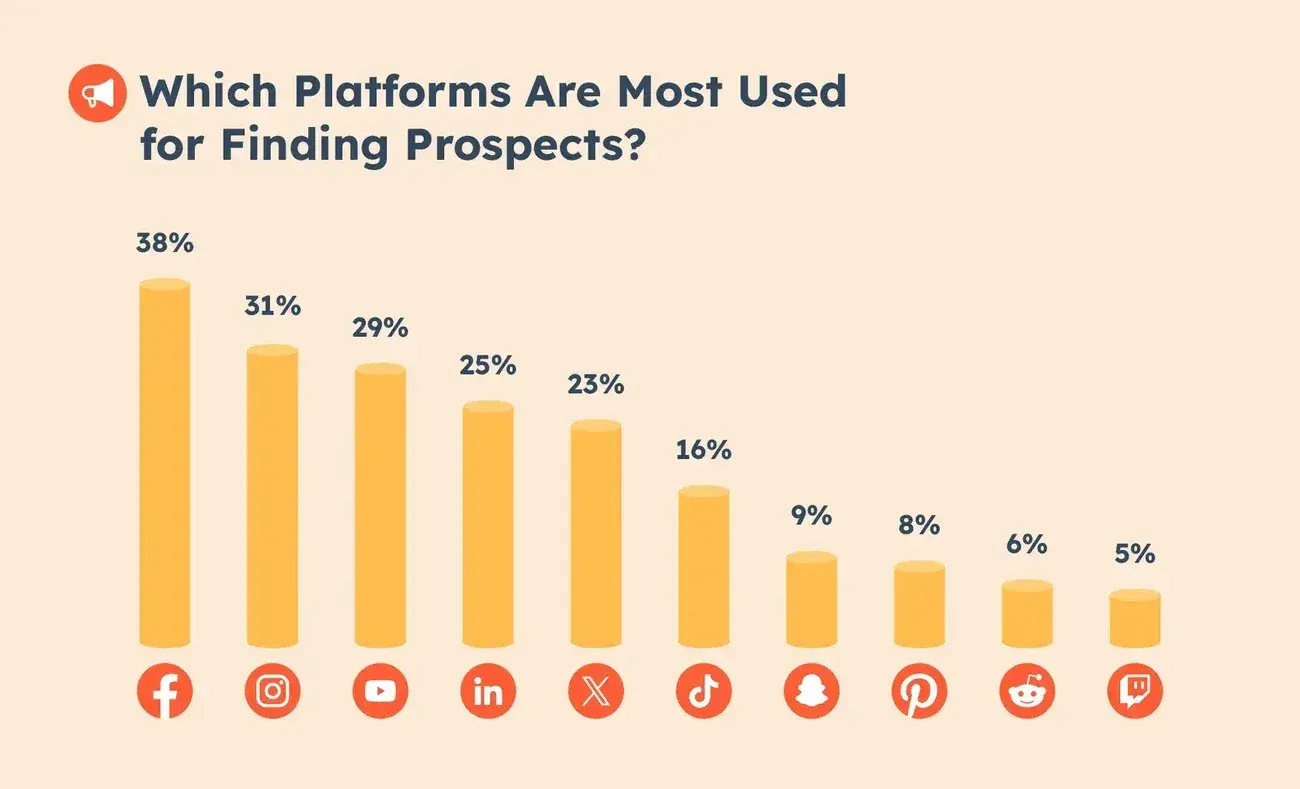
Lead generation and prospecting tools can also help by aggregating potential leads and tracking their status. That way, you always know how many leads you‘ve got and what stage they’re in.
7. Maintain the health of your pipeline.
Of prospects, 60% say no four times before saying yes. Still, nearly half of salespeople never follow up. This indicates that you‘ll definitely lose leads if you don’t establish a five (or more) step follow-up process throughout your sales pipeline.
Give your team a system for following up with leads, including timing, cadence, and contact method. Set clear expectations like:
- Every inbound lead is contacted within six hours or less.
- Every lead receives 10-12 touches spread out over one month.
- Every lead receives various email, phone, and social media touches.
- Every touch includes new information or resources.
If there are any relevant digital assets your organization manages for this purpose, they should be easily accessible to the sales team. Making these resources readily available can streamline follow-up efforts and ensure consistency in communication.
A uniform follow-up strategy helps your reps maintain clean pipelines by telling them when to disqualify prospects. If a prospect hasn't responded by the last touch, you can remove them from the pipeline.
Pro tip: If you mainly follow up with leads via email, check out our free email template builder to streamline the process of creating follow-up emails.
8. Clean your sales pipeline regularly.
Cleaning up your sales pipeline is essential if you want accurate sales forecasts. Most forecasts rely on the stage each opportunity is in to estimate how likely it is to close. However, this doesn’t always tell the full story.
Say, you sent a proposal for a $2,000 deal to a prospect a month ago, but since then, they haven’t responded to any of your calls or emails. Despite being in the “negotiation” stage, this deal is clearly losing momentum.
If your sales forecast still counts it as a high-probability opportunity, you might overestimate your expected revenue for the next month. In reality, this deal may be a lost cause, and your forecast could be off by thousands of dollars.
The longer stale deals remain in your pipeline, the wider the gap between expectation and reality grows. This is why regularly cleaning your pipeline is so important. Take time to remove opportunities that are no longer viable and re-qualify the ones that are still active. This keeps your sales forecast aligned with what's actually happening, allowing for more realistic planning.
Another crucial step is keeping your communication organized. Your email inbox is a key part of your sales process, so it should reflect the current status of your deals. By maintaining an organized inbox (using an inbox zero approach, for instance), you can quickly identify stale conversations or opportunities that need a follow-up.
You can automate this process with tools like Clean Email, which helps declutter your inbox and ensures you're not missing any follow-ups that could push a deal over the line.
.png)
Free Sales Metrics Calculator
A free, interactive template to calculate your sales KPIs.
- Average Deal Size
- Customer Acquisition Cost (CAC)
- Customer Lifetime Value (CLV)
- And more!
Download Free
All fields are required.
.png)
How to Run a Sales Pipeline Review
Just like a regular health check-up helps catch potential issues early, reviewing your sales pipeline regularly helps spot bottlenecks and inactive leads before they derail your efforts.
Here's how you can run an effective sales pipeline review to keep things on track.

1. Gather relevant data.
First things first — gather all the essential data from your CRM and sales tools. This should include information on your current leads, conversion rates, deal sizes, and how long prospects are spending in each stage of your pipeline.
In my experience, the best sales teams always have accurate, up-to-date data. Detailed reports and analytics give you a clear view of your pipeline’s health and allow you to pinpoint areas that need attention. If your data isn’t up to date, the review process won’t give you a true picture of what’s really going on, which can lead to missed opportunities or wasted efforts.
2. Prepare a clear agenda and structure.
Before the review, I suggest creating a structured agenda that outlines specific topics to cover. I recommend using a framework like the Create-Advance-Close model to organize the discussion.
For example, if I were a salesperson, I would allocate time to discuss new deals entering the pipeline (Create), deals progressing through stages (Advance), and deals nearing closure (Close). I would also ensure that clear time limits are set for each section to maintain focus. Without this, reps can easily go off on a tangent and turn the review session into extended coaching sessions.
This structure helps ensure the meeting stays on track and covers all crucial aspects of the pipeline, from lead generation to deal closure.
3. Review key pipeline metrics.
I recommend kicking off your pipeline review meeting by focusing on key pipeline metrics that offer actionable insights. Look at metrics like the number of qualified leads, MQL to SQL conversion rates, win rate, average deal size, and the length of your sales cycle. These metrics give you a snapshot of your pipeline's overall health and performance.
I also suggest discussing any significant shifts or trends in these metrics compared to previous periods. For example, if you notice a dip in your win rate or a slowdown in the sales cycle, this could signal areas that need attention. A data-driven approach like this helps ensure that the conversation remains objective and focused on what truly matters.
When discussing these trends, dive deeper into any metrics that show concerning patterns or unexpected changes. This helps uncover the root causes and allows your team to adjust strategies accordingly.
4. Analyze deal movement and stagnation.
One of the most critical steps in a sales pipeline review is identifying where deals are stalling or getting stuck. These bottlenecks can significantly impact your ability to close deals and forecast revenue accurately.
Start by looking at where deals are stagnating in the pipeline. Are leads stuck in the “proposal” stage for weeks without progress? Are opportunities in the “negotiation” stage going quiet with no responses? Understanding why this is happening is key to fixing the problem.
There are a number of reasons why deals stall:
- Inadequate follow-up. If your sales reps aren’t following up consistently or at the right times, prospects might lose interest or simply forget about the deal. According to LeanData, 38% of reps take more than two weeks to follow up on newly assigned leads. You’ll want to look for patterns where opportunities might be slipping through the cracks and ensure there’s a clear follow-up strategy in place.
- Poor lead quality. Sometimes deals stall because the initial leads weren’t well-qualified. Maybe the leads don’t have the real need for your solution or lack the authority to make a purchasing decision. It’s essential to evaluate whether your lead qualification process is strong enough or if certain types of leads should be filtered out earlier in the pipeline.
- Issues with the sales pitch. If leads are dropping off after a pitch or demo, the issue might lie in how the value of your solution is being communicated. Perhaps your pitch isn‘t addressing the key pain points of the prospect, or you’re not showing them the full ROI of the product. In this case, adjusting your approach and providing your sales team with better tools or training can help move deals forward.
Pointing out these obstacles helps the team take targeted actions to resolve them, ensuring smoother transitions through each pipeline stage.
5. Update and adjust strategies.
Based on the insights you’ve gathered, update and refine your sales strategies. Successful teams regularly adjust their approach — whether it's revising lead qualification criteria, refining sales pitches, or adopting new tools to streamline processes.
For example, if you’re bringing in too many low-quality leads, it’s time to tighten your criteria. If your sales team struggles to close deals, maybe your pitch needs to better address objections or highlight key benefits.
Implementing new tools can also help, such as CRM systems or email automation, to improve efficiency and keep follow-ups on track.
Clear communication of these changes is key. Make sure your team understands why the adjustments are being made and offer training to ensure everyone is aligned. Regular strategy updates keep your pipeline dynamic and help you stay competitive in a changing market.
6. Create an accountability mechanism for reps and managers.
One major pitfall in pipeline reviews is the lack of accountability for both you and your team. To avoid this, make sure you establish clear action items for everyone involved before concluding the review. These should be specific, measurable, and time-bound.
I’ve noticed that business-savvy teams assign ownership for each action item and set deadlines. Additionally, they agree on how progress will be tracked and when these items will be reviewed next.
This step ensures that the insights gained during the review translate into concrete actions that move deals forward.
Sales Pipeline Reviews vs. Sales Forecast Reviews
While both sales pipeline reviews and sales forecast reviews are essential for your team’s success, it’s important to keep them separate.
A sales forecast review focuses specifically on deals that are likely to close within a given timeframe. The goal here is to help you and your team predict whether you’ll hit your quota. This review looks at the deals already in the pipeline and assesses their likelihood of closing, based on factors like the stage they're in and historical conversion rates. It’s a forward-looking meeting that gives managers a clear picture of whether they’re on track to meet their sales targets.
On the other hand, a sales pipeline review is all about moving deals through the sales process more efficiently. This meeting should center around fresh sales opportunities — the leads that are still early in the pipeline. It’s a strategic look at where prospects are getting stuck or stalled, and how to help them move forward. The focus is on optimizing the pipeline, not just forecasting future outcomes.
I’ve noticed sales managers make the mistake of jumping in to help during the later stages of the sales process, often when it’s too late to make a meaningful impact. At this point, the deal is already in motion, and the outcome is harder to influence.
To truly make a difference, managers should be involved earlier on, during the initial stages of the opportunity, where their guidance can shape the strategy, address potential obstacles, and prevent issues from developing down the line.
How to Clean Up Your Sales Pipeline
I've always believed that a clean, well-organized sales pipeline is the key to maximizing efficiency and closing more deals. Firms with structured pipelines achieved a 16% higher win rate, indicating that a clear and organized pipeline directly contributes to closing more deals.
Over the years, I‘ve seen systematic approaches keep pipelines neat and tidy, and I’m excited to share these tips with you.
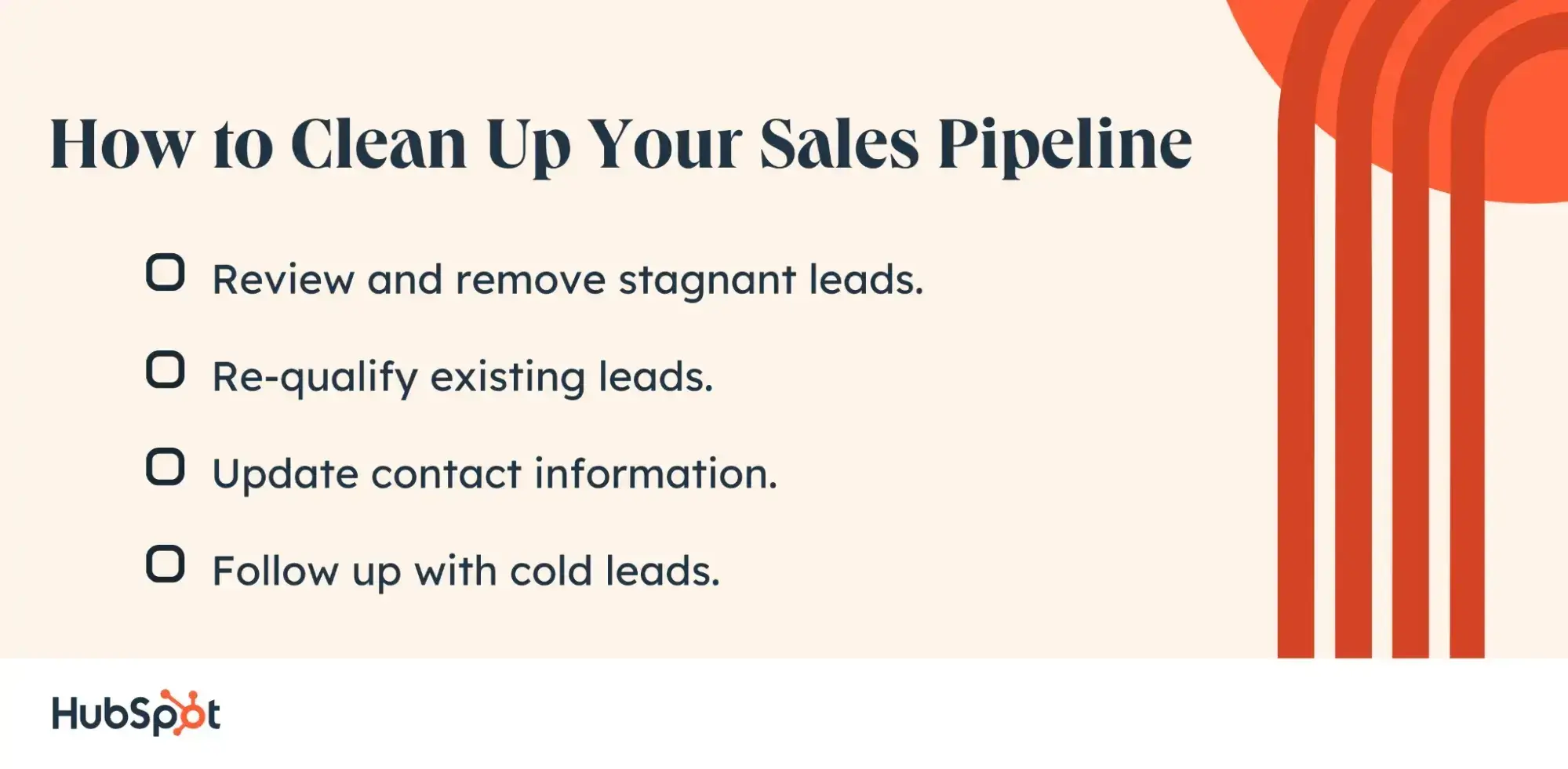
1. Review and remove stagnant leads.
Identify leads that have been in the same stage for too long. These stagnant leads are unlikely to convert and only clutter your pipeline.
Use your CRM to filter out these leads based on inactivity. Once identified, either remove them or move them to a nurture campaign if there’s potential for future engagement. Research shows that 80% of new leads never translate into sales due to a lack of lead nurturing. This means that if you nurture them, they might convert into a sale.
Regularly clearing out these leads keeps your pipeline dynamic and focused on active prospects.
2. Requalify existing leads.
Over time, some leads in your pipeline may not have been fully qualified, or their circumstances may have changed. For example, a lead who seemed interested in your product a few months ago might now be dealing with budget cuts or a shift in company priorities.
It’s important to regularly requalify leads to ensure you’re focusing your energy on the right prospects. This process involves reassessing your leads based on updated criteria such as budget, authority, need, and timeline (BANT).
Requalifying your leads isn’t just about weeding out the unqualified ones; it’s also an opportunity to gather fresh information. During this process, you can update outdated contact details, refresh notes on the prospect’s pain points, or confirm any new decision-makers.
This ensures your pipeline is populated with the most relevant and up-to-date information, which in turn strengthens your sales strategy.
3. Update contact information.
Many deals are lost when decision-makers change within an organization. As a sales rep, it's vital to stay informed about any personnel changes in your prospect’s company. If a key decision-maker leaves, you may need to move the deal back to the qualification stage to identify the new point of contact and rebuild the relationship.
It's also important to verify close dates and make sure they align with the reality of the deal. If the close date is too optimistic, adjust it to reflect the true timeline; if it’s too far out, you may miss the chance to push the deal forward sooner.
Don’t forget to double-check the opportunity dollar values as well. If they’re set too high, your sales forecast might be overly optimistic, while too low a value could make you think you’re farther from your goal than you actually are. Keeping these numbers accurate helps you stay grounded and better manage expectations.
4. Follow up with cold leads.
Leads can sometimes go cold if they haven’t been contacted recently. Implement a follow-up strategy to re-engage these leads. Send personalized emails or make follow-up calls to check in and revive interest.
If a lead remains unresponsive after several attempts, consider removing them from your active pipeline. This ensures you focus on leads that are more likely to convert.
Pro tip: I recommend using automation tools to handle routine tasks like follow-up emails and data entry. Automation reduces the chances of human error and frees up your time for more strategic activities. Set up automated workflows in your CRM to ensure consistent follow-up and lead nurturing. This keeps your pipeline moving smoothly and ensures no lead falls through the cracks.
5. Streamline your pipeline stages.
Over time, sales pipelines can become bloated with too many stages or overly complex processes that slow down progress and create confusion. To ensure that your pipeline remains effective and manageable, regularly evaluate and streamline your sales pipeline stages.
Start by checking if any stage is redundant or no longer aligns with how prospects move through the buying journey. Are there too many steps between qualification and closing? Are certain stages causing unnecessary friction or delays? For instance, if you have a “follow-up” stage after every meeting, but it’s not adding value or leading to more sales, consider eliminating it.
By simplifying your pipeline, you make it easier for sales reps to manage leads, ensure consistent follow-ups, and avoid confusion. A streamlined pipeline also helps reduce the risk of deals getting lost or stuck in overly complicated processes, allowing your team to focus on what really matters — closing deals and driving revenue.
Sales Pipeline Analysis: Key Sales Pipeline Metrics to Track
When reviewing your pipeline, you should know some baseline metrics to help determine whether your pipeline is healthy. Use these metrics to gauge the health of your sales pipeline — and, from there, the health of your team, department, and business.
While there are many sales pipeline analysis metrics to consider, I've narrowed it down to six key indicators that provide the most valuable insights for optimizing sales performance and forecasting.
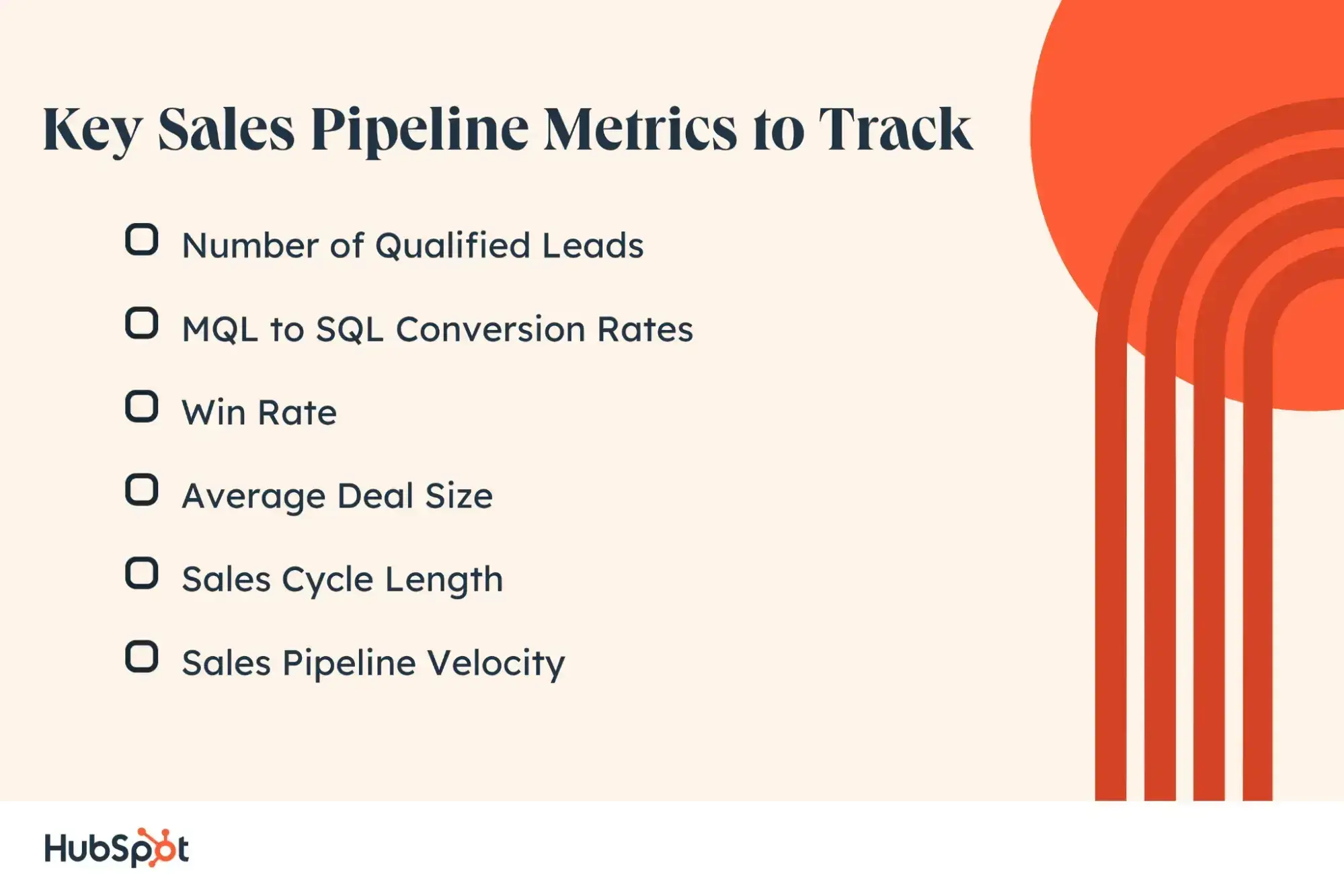
1. Number of Qualified Leads
Tracking the number of qualified leads entering your pipeline each month is crucial. This metric shows if your lead generation efforts are effective. For example, if you receive 200 leads in a month and qualify 50 of them, your qualification rate is 25%.
This metric will help you understand the quality of your leads and adjust your marketing strategies accordingly.
Use this metric to gauge the workload and identify if you have enough opportunities to meet your sales targets.
Pro tip: Ensure the deals are evenly distributed across different stages to prevent bottlenecks.
2. MQL to SQL Conversion Rates
MQL to SQL conversion rate measures the percentage of marketing-qualified leads that become sales-qualified leads. It’s a reliable way to assess lead quality and indicates the success of your lead generation campaigns.
The average MQL to SQL conversion rate across popular industries is about 16%. This means that for every 100 MQLs, a marketing campaign should aim to convert at least 16 into SQLs.
To calculate, divide the number of leads that advance by the total number of leads at the initial stage and multiply by 100.
You can use this metric to identify strengths and weaknesses in your sales process and to optimize each stage for better conversion.
3. Win Rate
Win rate measures the percentage of closed deals out of the total opportunities. It helps gauge the effectiveness of your sales process and team performance.
The win rate percentage is calculated by dividing the number of closed deals by the number of leads, opportunities, or meetings. This can also be done for each stage of the sales process.
For example, if you had 50 opportunities and closed 10 deals, your win rate is 20%. This metric indicates your overall sales effectiveness.
4. Average Deal Size
Average deal size indicates the typical value of closed deals.
Formula: Total revenue from all deals / Number of deals. For example, if you have $500,000 in total revenue from 50 deals, the average deal size is $500,000 / 50 = $10,000.
Knowing your average deal size helps you set realistic sales targets and forecasts and can guide your focus toward higher-value opportunities. To increase it, focus on increasing this metric by upselling and cross-selling.
5. Sales Cycle Length
Sales cycle length measures the average time it takes to close a deal from the initial contact to closing.
Formula: Total number of days to close all deals / Number of deals. If it takes 1,000 days to close 50 deals, the average sales cycle length is 1,000 / 50 = 20 days.
This metric helps identify inefficiencies in your sales process and areas for improvement, aiming to shorten the cycle and close deals faster.
6. Sales Pipeline Velocity
Pipeline velocity is one of the key sales pipeline analysis metrics, and it measures the speed at which leads move through your sales pipeline.
Calculate it using the formula: (Number of Opportunities x Win Rate x Average Deal Size) / Sales Cycle Length.
For instance, suppose you have 50 opportunities in your sales pipeline. Your average win rate is 40%, and your average deal size is $10,000. The sales process usually takes 70 days, from the initial contact to the signed proposal.
Your pipeline velocity = 50 x .4 x 10,000 / 70, or $2,587.14.
That means approximately $2,587.14 is moving through your sales pipeline every day. Obviously, the higher your velocity, the better.
So, how can you increase the pipeline velocity?
You can pull four main levers, and unsurprisingly, they correlate to the four factors of the equation.
- The number of total opportunities. Increase your prospecting efforts to get more opportunities.
- Win rate. One-on-one weekly coaching helps sales reps deliver high performance. You can improve this metric by investing in sales training and enablement.
- Deal size. Help your reps sell bigger deals by teaching them how to upsell, cross-sell, or target larger customers.
- Sales cycle. Have a well-defined sales process and ensure reps follow it. Leave room to test new strategies like the growth of AI or buyers’ preference for virtual shopping, and adapt accordingly to reduce your sales cycle.
An Easy Sales Pipeline Template
A sales pipeline template lets you set up your pipeline in a spreadsheet. Simply plug in each deal, its expected value, and the probability of closing, and you'll get the weighted average for that deal.
This sales pipeline template also has columns for the assigned salesperson, the prospect's contact information, and the next steps.
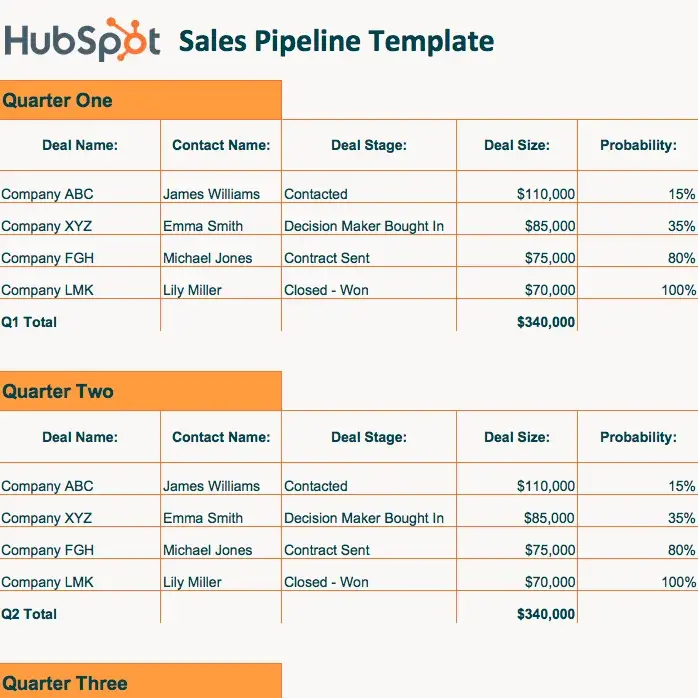
Download HubSpot’s Free Sales Pipeline Template
While you can manage your sales pipeline in an Excel spreadsheet, using a CRM is much easier. The HubSpot CRM gives you an up-to-date view of your sales pipeline, multiple ways to sort your deals, automatic activity tracking (so you don't need to log calls or emails manually), and detailed contact records for every lead.
Sales Pipeline Report
The next step in managing your sales pipeline is creating reports. Using reports, you can predict when opportunities will close and get a clearer picture of the pipeline's health. But what should you include in your sales pipeline report?
- The number of opportunities in the pipeline. This is an excellent indicator of whether a pipeline has enough opportunities to meet revenue goals and quotas.
- Opportunity sizes. If an opportunity closes, how much value will it provide to the sales team?
- Close date for each opportunity. This tells you when an opportunity might close. It also allows salespeople and managers to forecast expected revenue.
- An overview of the pipeline over time. Is your pipeline growing? Zooming out and looking at the pipeline history will show you the answer.
Ready for Sales Pipeline Management?
Mastering your sales pipeline means mastering your results. The sales pipeline benefits the entire organization, not just the sales team. When everyone aligns around revenue goals, every team succeeds.
A well-managed pipeline is dynamic, requiring constant attention, regular reviews, and adaptability to market changes and customer behaviors. Successful sales leaders and reps view their pipeline as a strategic asset, not just a reporting tool.
Whether your business faces disruption from new competitors, major opportunities, industry shifts, or internal changes, use these tips and the sales pipeline template to forecast your deals and manage your sales pipeline effectively.
.png)
Free Sales Metrics Calculator
A free, interactive template to calculate your sales KPIs.
- Average Deal Size
- Customer Acquisition Cost (CAC)
- Customer Lifetime Value (CLV)
- And more!
Download Free
All fields are required.
.png)
.png?width=112&height=112&name=timeline%20(1).png)
.jpg)
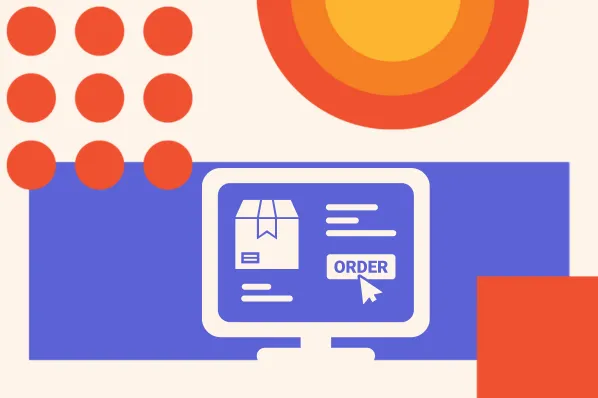



![5 Reasons Why Sales Teams Miss Revenue Targets [+ How to Meet Them]](https://53.fs1.hubspotusercontent-na1.net/hubfs/53/revenue-targets-1-20250224-8507178.webp)


.jpg)
